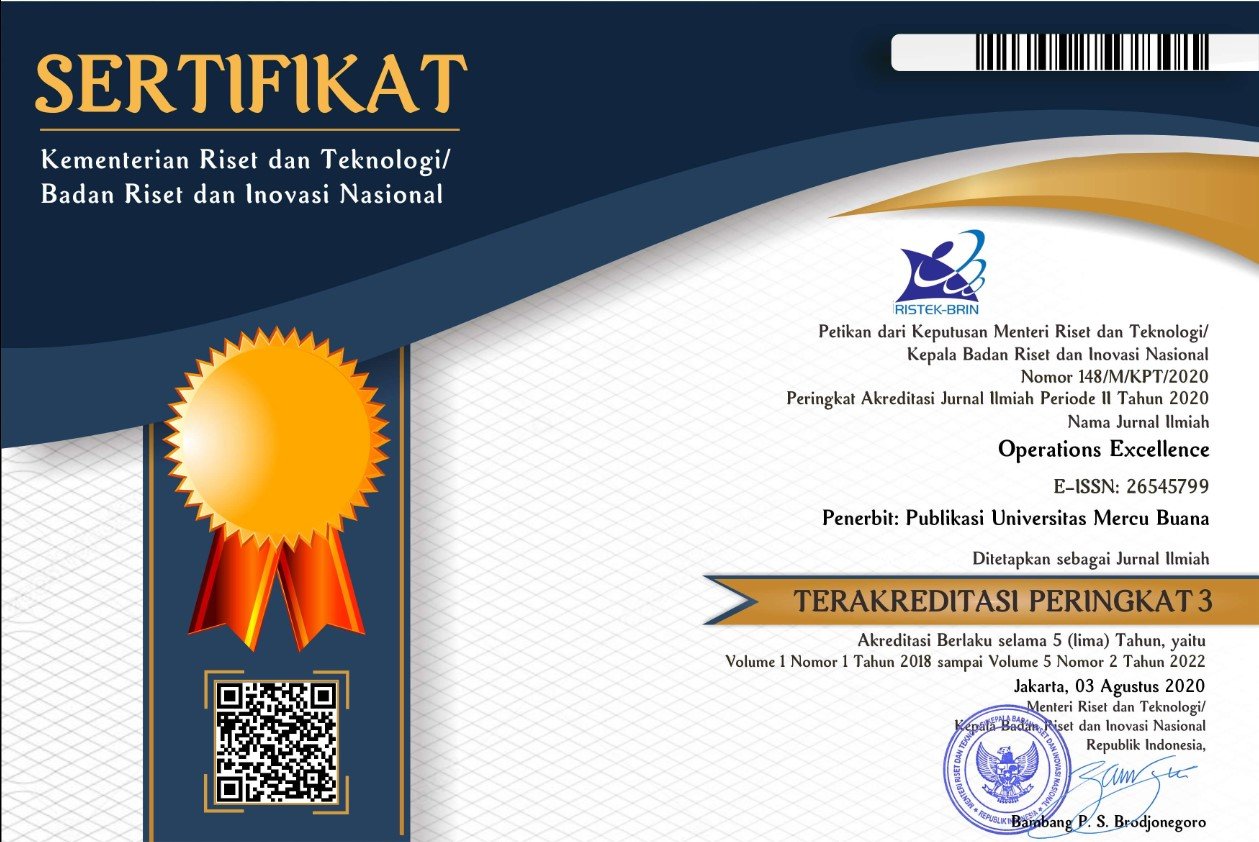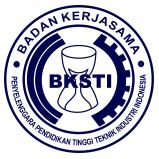Perencanaan Proyek Struktur Semi Gantry Crane Menggunakan Critical Chain Project Management
Abstract
Project completion work has problems related to project completion not being on time, thereby increasing costs and resources. The work on the gantry crane structure includes projects that experience problems related to incompatibility between project planning and actual project work. This study aims to plan project activities by speeding up processing time and providing prevention strategies to minimize project delays. This study uses the critical chain project management method using the cut & paste method by 30%. The results showed the total buffer time was ten days, consisting of eight project buffer days and two feeding buffer days. The total time for the semi-gantry crane structure project has accelerated from 43 days to 33 days. Suggestions for prevention that can be done to complete the project according to the plan are adding project workers, adding tools or machines, and eliminating multitasking activities that cause project workers not to finish their work immediately.
Keywords
Full Text:
PDFReferences
Ghaffari, M., & Emsley, M. W. (2015). Current status and future potential of the research on Critical Chain Project Management. Surveys in Operations Research and Management Science, 20(2), 43–54. https://doi.org/10.1016/j.sorms.2015.10.001
Goldratt, E. M. (1997). Critical Chain. North River Press. https://books.google.co.id/books?id=FKimAILd3NsC
Habibi, A., Supriyadi, S., & Wibowo, T. J. (2016). Analisis Penjadwalan Pembuatan Heat Exchanger Menggunakan Critical Path Method. Jurnal INTECH Teknik Industri Universitas Serang Raya, 2(1), 19–27. https://doi.org/10.30656/intech.v2i1.860
Hall, N. G. (2012). Project management: Recent developments and research opportunities. Journal of Systems Science and Systems Engineering, 21(2), 129–143. https://doi.org/10.1007/s11518-012-5190-5
Hebert, J. E., & Deckro, R. F. (2011). Combining contemporary and traditional project management tools to resolve a project scheduling problem. Computers & Operations Research, 38(1), 21–32. https://doi.org/10.1016/j.cor.2009.12.004
Hindar, N. I. (2014). Analisis Jalur Kritis untuk Mengatasi Keterlambatan Proses Pemasangan Produk Interior Furniture dengan Metode Pert pada Salah Satu Proyek PT Pap Cabang Bandung. Jurnal Operations Excellence: Journal of Applied Industrial Engineering, 6(3), 290–308. https://publikasi.mercubuana.ac.id/index.php/oe/article/view/517
Horine, G. (2009). Absolute Beginner’s Guide to Project Management. Que. https://books.google.co.id/books?id=lvUQmQEACAAJ
Izmailov, A., Korneva, D., & Kozhemiakin, A. (2016). Effective Project Management with Theory of Constraints. Procedia - Social and Behavioral Sciences, 229, 96–103. https://doi.org/10.1016/j.sbspro.2016.07.118
Jo, S.-H., Lee, E.-B., & Pyo, K.-Y. (2018). Integrating a Procurement Management Process into Critical Chain Project Management (CCPM): A case-study on oil and gas projects, the piping process. Sustainability, 10(6), 1–22. https://doi.org/10.3390/su10061817
Leach, L. P. (1999). Critical Chain Project Management Improves Project Performance. Project Management Journal, 30(2), 39–51. https://doi.org/10.1177/875697289903000207
Leach, L. P. (2014). Critical Chain Project Management, Third Edition. Artech House. https://books.google.co.id/books?id=UOxPAwAAQBAJ
Liu, J., & Whangbo, T.-K. (2012). A Study on the Buffer Sizing Method of CCPM Technique Using Statistical Analysis. Convergence and Hybrid Information Technology (pp. 672–679). Springer Berlin Heidelberg. https://doi.org/10.1007/978-3-642-32692-9_84
Long, L. D., & Ohsato, A. (2008). Fuzzy critical chain method for project scheduling under resource constraints and uncertainty. International Journal of Project Management, 26(6), 688–698. https://doi.org/10.1016/j.ijproman.2007.09.012
Miranda, S., & Tripiawan, W. (2019). Perbandingan Penentuan Waktu Baku Menggunakan Metode Time Study dan Critical Path Method (CPM). Jurnal Sistem Dan Manajemen Industri, 3(1), 19–30. https://doi.org/10.30656/jsmi.v3i1.1418
Nalhadi, A., & Suntana, N. (2017). Analisa Infrastruktur Desa Sukaci-Baros Dengan Metode Critical Path Method (CPM). Jurnal Sistem Dan Manajemen Industri, 1(1), 35. https://doi.org/10.30656/jsmi.v1i1.167
Nasution, S. R. (2014). Penerapan Metode Critical Chain Project Management untuk Perencanaan Proyek Very Low Pressure Phase-II KEI Ltd. Jurnal Teknologi Technoscientia, 6(2), 211–221. https://ejournal.akprind.ac.id/index.php/technoscientia/article/view/573
Nugroho, W., Faiizuddaroini, M., Nalhadi, A., Suryani, S., & Supriyadi, S. (2020). Evaluation of Fabrication Concrete Wave Breaker Project Scheduling with the Critical Chain Project Management Method, Proceedings of the 1st International Multidisciplinary Conference on Education, Technology, and Engineering (IMCETE 2019). 170–173. https://doi.org/10.2991/assehr.k.200303.041
Ordoñez, R. E. C., Vanhoucke, M., Coelho, J., Anholon, R., & Novaski, O. (2019). A Study of the Critical Chain Project Management Method Applied to a Multiproject System. Project Management Journal, 50(3), 322–334. https://doi.org/10.1177/8756972819832203
Parekh, V., Asnani, K., Bhatt, Y., & Mulchandani, R. (2020). Comparison between Critical Path Method (CPM) and Last Planners System (LPS) for Planning and Scheduling METRO Rail Project of Ahmedabad. CIGOS 2019, Innovation for Sustainable Infrastructure. 519–524. https://doi.org/10.1007/978-981-15-0802-8_81
Pellerin, R., & Perrier, N. (2019). A review of methods, techniques and tools for project planning and control. International Journal of Production Research, 57(7), 2160–2178. https://doi.org/10.1080/00207543.2018.1524168
Prajapati, M. P., & Yadav, N. B. (2017). Buffer Based CCPM Scheduling: A Modern Approach for Indian Constraints. Kalpa Publications in Civil Engineering, 1, 291–300. https://easychair.org/publications/paper/xd6
Rand, G. K. (2000). Critical chain: the theory of constraints applied to project management. International Journal of Project Management, 18(3), 173–177. https://doi.org/10.1016/S0263-7863(99)00019-8
Roghanian, E., Alipour, M., & Rezaei, M. (2018). An improved fuzzy critical chain approach in order to face uncertainty in project scheduling. International Journal of Construction Management, 18(1), 1–13. https://doi.org/10.1080/15623599.2016.1225327
Sahrupi, S., Supriyadi, S., & Harisni, M. U. (2021). Usulan Penerapan Metode Lean Project Management Pada Pembangunan Pelebaran Gedung Gitet Cilegon Baru PT. PLN (Persero). Operations Excellence Journal of Applied Industrial Engineering, 13(3), 407–420. https://doi.org/10.22441/oe.2021.v13.i3.037
San Cristóbal, J. R., Carral, L., Diaz, E., Fraguela, J. A., & Iglesias, G. (2018). Complexity and Project Management: A General Overview. Complexity, 2018, 4891286. https://doi.org/10.1155/2018/4891286
Saputra, A., Putra, G., & Aguslita, F. (2021). Pengendalian Waktu Proyek Menggunakan Metode Critical Chain Project Management (CCPM) Studi Kasus Pembangunan Proyek Irigasi Tahap II Kabupaten Aceh Barat. Jurnal Teknik Industri, 11(3), 204–215. https://doi.org/10.25105/jti.v11i3.13063
Saputra M, D. A., Satria, E., & Pandy, G. A. (2016). Optimalisasi Proses Perakitan Pesawat Tanpa Awak dengan Metoda Critical Path Methods (CPM). Jurnal Optimasi Sistem Industri, 15(1), 87. https://doi.org/10.25077/josi.v15.n1.p87-92.2016
Shofa, M. J., Listiyana, L., & Cahyadi, D. (2018). Usulan Perbaikan Proses Cross Drainage untuk Mempercepat Waktu Proyek Pembangunan Jalan Raya. Jurnal INTECH Teknik Industri Universitas Serang Raya, 4(2), 71–76. https://doi.org/10.30656/intech.v4i2.1054
Steyn, H. (2001). An investigation into the fundamentals of critical chain project scheduling. International Journal of Project Management, 19(6), 363–369. https://doi.org/10.1016/S0263-7863(00)00026-0
Tripiawan, W., & Miranda, S. (2020). Research on a Project Schedule of Factory Renovation for Manufacturing Plants in Bandung. IOP Conference Series: Materials Science and Engineering, 722(1), 12052. https://doi.org/10.1088/1757-899x/722/1/012052
Vidal, L., & Marle, F. (2008). Understanding project complexity: implications on project management. Kybernetes, 37(8), 1094–1110. https://doi.org/10.1108/03684920810884928
Wang, W., Wang, X., Ge, X., & Deng, L. (2014). Multi-objective optimization model for multi-project scheduling on critical chain. Advances in Engineering Software, 68, 33–39. https://doi.org/10.1016/j.advengsoft.2013.11.004
DOI: http://dx.doi.org/10.22441/oe.2022.v14.i2.051
Refbacks
- There are currently no refbacks.
Copyright (c) 2022 Operations Excellence: Journal of Applied Industrial Engineering

This work is licensed under a Creative Commons Attribution-ShareAlike 4.0 International License.
Journal ISSN:
| Print ISSN: 2085-4293 | |
| Online ISSN: 2654-5799 |
Tim Editorial Office
Operations Excellence: Journal of Applied Industrial Engineering
Magister Teknik Industri Universitas Mercu Buana
Jl. Raya Meruya Selatan No. 1 Kembangan Jakarta Barat
Email: [[email protected]]
Website: http://publikasi.mercubuana.ac.id/index.php/oe
Journal DOI: 10.22441/oe
The Journal is Indexed and Journal List Title by:

.png)
.png)
.png)


Operations Excellence: Journal of Applied Industrial Engineering is licensed under a Creative Commons Attribution-NonCommercial-ShareAlike 4.0 International License.











